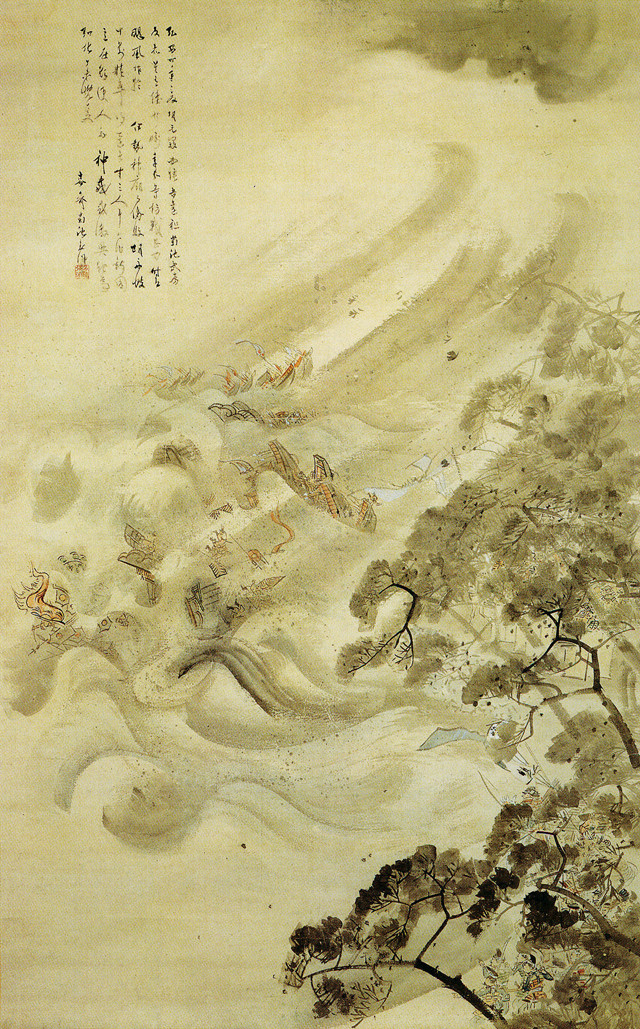
by Julia Rosen Monday, March 2, 2015

A new study suggests that a Japanese legend — which holds that "divine wind," or kamikaze, defeated Mongol invaders in the 13th century, as depicted in this 1847 painting by Kikuchi Yōsai — may have some merit. Credit: Public domain.
Like any good conqueror, Kublai Khan just wanted to expand his empire. So in the late 13th century, the grandson of Genghis Khan launched a mythic fleet to seize control of Japan. According to Japanese legend, however, the Mongol ships met with typhoons of equally mythic proportions, which quashed their repeated invasions — twice.
These storms, which spared Japan from occupation in 1274 and again in 1281, became known as the “divine wind,” or kamikaze, but many scientists and historians have questioned their existence. Now, a new study suggests there may be truth to the tales: researchers recently found evidence of increased typhoon activity around the time of the attacks, including signs that two major storms made landfall not far from the site of Mongol shipwrecks.
Doubts had grown about the kamikaze typhoons in recent decades, partly because events of this size would be unlikely today, says Kinuyo Kanamaru, a geologist at the University of Massachusetts at Amherst (UMass) and an author of the study, published in Geology. So Kanamaru and others, including lead author and UMass colleague Jonathan Woodruff, went looking for hard evidence beneath the waters of Lake Daija on Kyushu, the southernmost of Japan’s four main islands.
They picked the site because it sits along the same likely storm track less than 120 kilometers from where archaeologists think the Mongols landed, and for one other reason. “In Japan, people believe in spirits that protect them. Those spirits tend to live in a small lake or a pond or a gigantic tree,” Kanamaru says. Because Lake Daija had a legend associated with it — locals believed a serpent inhabited the lake — the researchers hoped it would have a long sedimentary record that might stretch all the way back to the 1200s.
They also hoped it would be a good place to look for evidence of ancient storm surges. With only a thin barrier of beach separating the lake from the ocean, the researchers reasoned that seawater would have washed over the beach during big typhoons, leaving clues in the sediments. In particular, the researchers searched for physical signs of disturbed sediments, as well as changes in the concentration of strontium, which is more enriched in seawater than in the freshwater of the lake.
Their results revealed elevated strontium levels and changes in sediment properties between A.D. 250 and 1600, suggesting that storm surges, and thus typhoons, used to happen more frequently in this part of Japan than they do today. Within this period of heightened typhoon activity, the researchers identified two pronounced storm deposits that dated to the late 1200s. Although they could not constrain the deposits’ ages to specific years, the authors suggested the layers might be direct evidence of the kamikaze typhoons of 1274 and 1281.
Kanamaru says it’s unlikely the deposits were produced by tsunamis — another way of flooding the lake — because Lake Daija sits on the west coast of Kyushu, on the opposite side of the island from the faults that might trigger them. There are also no historical records of tsunamis striking at this time.
“To say that the Mongol invasion was knocked back by hurricanes sounds like a myth,” says Jonathan Nott, a geologist at James Cook University in Cairns, Australia, who was not involved with the study and reviewed the paper for Geology. But he says Woodruff’s team seems to have identified evidence of the storms in the geologic record. “It was very nicely and cleverly done,” says Kam-Biu Liu, an oceanographer at Louisiana State University who also was not involved in the work. “This is a very good way of making these connections.”
Although the Japanese believed spirits sent the kamikaze typhoons to protect them, the credit appears to belong to the tropical Pacific, which experienced frequent El Niños in the late 13th century. Using complementary studies of historical typhoon activity in China and Japan, scientists have previously found that storms veer toward Japan more often during El Niño-heavy periods and toward China under more dominant La Niña climate states.
This makes the kamikaze events one of the first recorded examples of how extreme weather can shape major geopolitical boundaries, Kanamaru says.
© 2008-2021. All rights reserved. Any copying, redistribution or retransmission of any of the contents of this service without the expressed written permission of the American Geosciences Institute is expressly prohibited. Click here for all copyright requests.